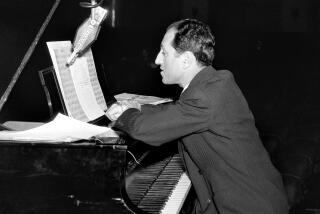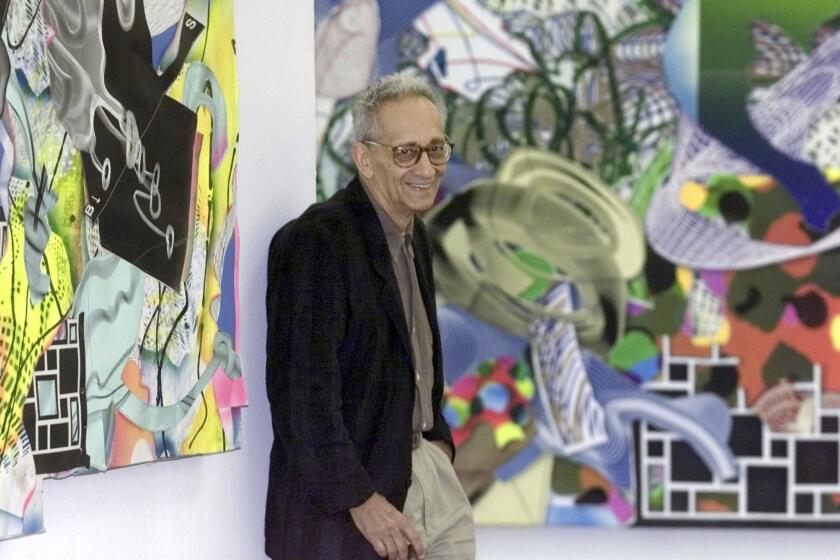Critic’s Notebook: John Adams on a big Beethoven kick in San Francisco
We cannot escape Beethoven.
The big music book of the fall was American musicologist Jan Swafford’s epic, 1,077-page “Beethoven: Anguish and Triumph,” published less than a year after British broadcaster John Suchet’s biography, “Beethoven: The Man Revealed.” No month passes without new Beethoven recordings.
The Los Angeles Philharmonic began the year with Michael Tilson Thomas’ momentous performance of Beethoven’s “Missa Solemnis,” with the addition of latter-day multimedia machinations. Meanwhile, composer John Adams last week conducted an L.A. Phil Green Umbrella concert highlighted by two outlandish theatrical works, by contemporary Austrian composers HK Gruber and Olga Neuwirth, that consciously confront Beethoven’s still lumbering shadow over Vienna. These follow in the 20th century American tradition, begun by Virgil Thomson and John Cage, of attempting to cut Beethoven down to size.
It can’t be done, even among such broad-minded and all-American musicians as Tilson Thomas and Adams, who both happen to be on big Beethoven kicks. Tilson Thomas may have turned his back momentarily on Beethoven in a matinee program Sunday that celebrated his 20th anniversary season with the San Francisco Symphony. He conducted a radiant performance of Stravinsky’s jazz-inspired “The Soldier’s Tale,” with Elvis Costello as the gregarious narrator, Malcolm McDowell as the sly devil and Nick Gabriel as the guileless soldier.
Along with the tang of ragtime and tango in this 1918 score for small ensemble, Stravinsky began to experiment with neo-Classical forms, his attempt to remake earlier musical style, including those of Beethoven’s era. Tilson Thomas, who will devote all of June in San Francisco to a Beethoven marathon, made the hymn at the end of “Soldier’s Tale” glow as if out of a late Beethoven quartet.
And thanks to Adams, that Beethoven loomed large at the start of Sunday’s matinee. The program began with the composer conducting his “Grand Pianola Music,” which the orchestra premiered in 1982. First, though, the composer described the Beethovenian psychedelic inspiration for the work for two pianos, three women’s voices, winds, brass and percussion.
He admitted that he had once, while a student, listened to a rehearsal of Beethoven’s Choral Fantasy under the influence of a chemical substance. He began to hallucinate that the piano was growing larger and larger, and from this came the inspiration a dozen years later for his extravagant, Minimalist two-piano concerto.
Beethoven was also in the picture three years ago when the San Francisco Symphony premiered Adams’ “Absolute Jest,” a concerto for string quartet and orchestra. Written for the St. Lawrence String Quartet, the piece is a huge fantasy on themes from late Beethoven string quartets.
Sunday night the St. Lawrence gave the world premiere of Adams’ Second String Quartet in Stanford University’s Bing Concert Hall. This time, Adams limited himself to a few bars from Beethoven’s penultimate piano sonata, Opus 110, and the “Diabelli” Variations for all his thematic material.
The biggest news of the day was of course the new quartet, which lasts 22 minutes and goes through extensive Beethovenian calisthenics. But it is a world away from “Grand Pianola Music,” which is an often static, glittering romp ending with what was, to serious Minimalists, a controversially catchy tune presented with wonderfully ostentatious flourish.
Yet Adams’ Second Quartet is even more psychedelic than “Grand Pianola Music,” if in different ways. The rate of change in his music has accelerated greatly over the last 32 years, and the complexity has become immense. Adams told the Stanford audience that he had urged the St. Lawrence (for which he also wrote his First String Quartet) to make it weird. The Beethoven themes in his new quartet continuously morph into surprising contours as if reflected in a fun house mirror.
Then again, weird is a St. Lawrence specialty. The program began with Haydn’s inventive String Quartet, Opus 20, No. 5, and it concluded with Beethoven’s visionary String Quartet, Opus 131. Those were made weird too. In performance, the St. Lawrence, with its wiry sound, can give the impression of four dazzling acrobats balancing precariously on a wire.
Fast movements are propelled in such a way that the slightest misstep would lead to disaster. Themes in the Beethoven were handled as if they might be radioactive, handed off from player to player with such rapidity they might have been radioactive.
Even so, Adams succeeded in out-weirding even Beethoven at his most audacious. The eight-bar phrase from Opus 110 that Adams obsesses over in the first of the quartet’s two movements has a cloud-like floating quality, which was exploited for its ambiguity. The metaphor for the fast ending might be the string quartet as particle accelerator, shooting “Diabelli” particles into each other and seeing what new particles with dazzlingly strange properties might result.
As for “Grand Pianola Music,” it dazzled too, especially with two splendid pianists, Orli Shaham and Marc-André Hamelin, and Synergy Vocals. Adams kept everything admirably on track. There were no particles, there were no new discoveries as there might have been had Tilson Thomas conducted, but a shoulder injury has caused him to cut back on the number of performances he can give while it heals. He has, after all, to be back in complete Beethoven shape by June, in time for his Beethoven marathon.
Twitter: @markswed
More to Read
The biggest entertainment stories
Get our big stories about Hollywood, film, television, music, arts, culture and more right in your inbox as soon as they publish.
You may occasionally receive promotional content from the Los Angeles Times.







